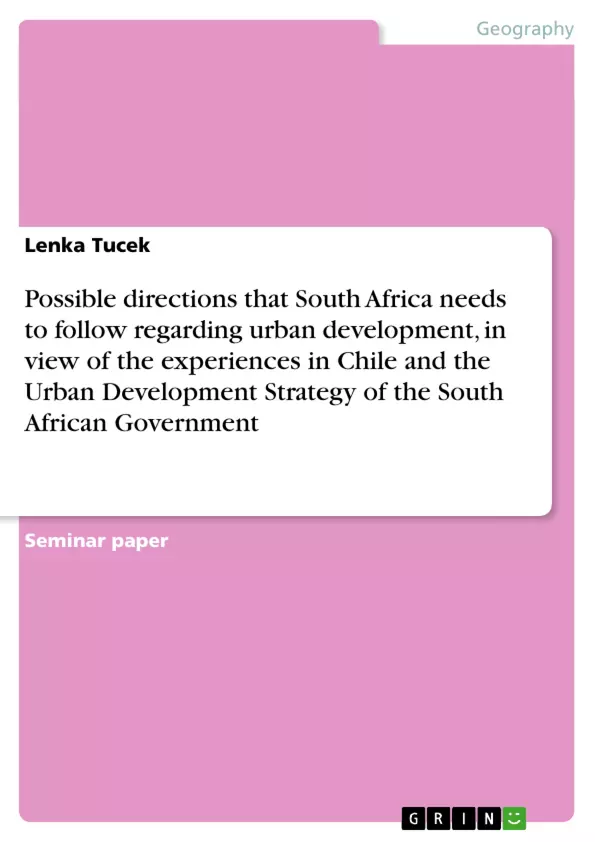Apartheid has been overthrown, a democratic government has been elected and South Africa is openeing itself to the world. But for the administration, the problems have grown more urgent, and the country now faces more than the already tragic heritage of apartheid. Due to decades of apartheid mismanagement urban areas are extremely inequitable and inefficient. They are the productive centres of the economy, but the majority of the urban residents live in very bad conditions and far away from their places of work. The quality of life of the South African people has to be improved massively, through creating jobs and deracialising the cities. Estimates of the present urban population in South Africa vary between 19.6 million and 26 million. By 2020, 75 per cent of the population will live and work in the cities and towns.1 The rate of urban population growth will be higher than for the population growth as a whole. Whereas in 1985 there were 20.7 million of the total South African population, resident in and on the edges of urban areas, by 2020 that will have increased to 43.7 million. 2 In the future, the urban centres, especially the metropolitan areas will function to an even greater degree than today as the social, economic and demographic heart of the country.
“It is apparent that African urbanisation levels certainly increase markedly over the next decade, and it is important that all decision makers involved in forward planning take account of this phenomenon.“3 In this assignment I will give an insight to the Urban Development Strategy of the Government of National Unity (GNU) (Chapter 2). Special attention will be given to the housing issue in Chapter 3. In Chapter 4 I will discuss the experiences in Chile, how different political systems influenced the urbanisation process in various ways. Chapter 5 deals with some national and international aspects, which have to be considered when strategies for development are designed and Chapter 6 includes some final comments on the urban development issue.
1 http://www.polity.org.za/govdocs/rdp/urban1.html page 2.
2 Smith, 1992: page 232.
3 Nattrass, 1983: page 21.
Inhaltsverzeichnis (Table of Contents)
- Introduction.
- The Urban Development Strategy of the South African Government.
- The Housing Issue.
- Urbanisation in Chile.
- Applied Strategies in Chile (1958–1993).
- Urbanisation in Chile and South Africa.
- National and International Aspects.
- Conclusion.
Zielsetzung und Themenschwerpunkte (Objectives and Key Themes)
This assignment aims to provide an overview of the Urban Development Strategy of the South African Government, focusing on the challenges and opportunities related to urban development in the country. It explores the housing issue, analyzes the experiences of Chile in urban development, and discusses the national and international aspects that need to be considered in developing urban strategies. The paper also emphasizes the importance of promoting sustainable urban development while addressing the legacy of apartheid and its impact on urban areas.
- Urban development strategy in post-apartheid South Africa
- Housing challenges and solutions
- Comparative analysis of urban development experiences in Chile
- National and international factors influencing urban development
- Sustainable urban development and social equity
Zusammenfassung der Kapitel (Chapter Summaries)
Chapter 1: Introduction The introduction sets the context for the assignment by discussing the challenges facing South Africa's urban areas in the aftermath of apartheid. It highlights the urgent need to address issues such as poverty, inequality, and spatial segregation. The chapter also outlines the key objectives and structure of the paper, with a focus on the Urban Development Strategy of the South African government.
Chapter 2: The Urban Development Strategy of the South African Government This chapter delves into the Urban Development Strategy of the South African government, outlining its strategic goals and priority action areas. It examines the government's approach to addressing issues such as job creation, housing, infrastructure, and transportation. The chapter emphasizes the importance of partnership between government, the private sector, and local communities.
Chapter 3: The Housing Issue This chapter focuses on the housing issue in South Africa, exploring the challenges and opportunities related to providing affordable and accessible housing. It examines the government's strategies for addressing housing shortages, improving living conditions in existing townships, and promoting security of tenure for urban residents.
Chapter 4: Urbanisation in Chile This chapter analyzes the experiences of Chile in urban development, exploring how different political systems have influenced the urbanisation process. It examines the applied strategies used in Chile during the period 1958-1993, and compares the Chilean experience to the South African context.
Schlüsselwörter (Keywords)
Urban development, South Africa, post-apartheid, housing, inequality, infrastructure, urban planning, sustainable development, urbanisation, Chile, political systems, national unity, partnership, community involvement.
- Quote paper
- Lenka Tucek (Author), 2001, Possible directions that South Africa needs to follow regarding urban development, in view of the experiences in Chile and the Urban Development Strategy of the South African Government, Munich, GRIN Verlag, https://www.grin.com/document/20047



